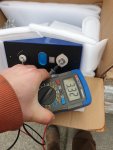In the event of a fault I would prefer the BMS be able to disconnect charging sources separate from loads.
I absolutely agree, that is a great overall design principle, need to buy a BMS designed for that ("separate ports" not "common port").
And all sources are wired to a separate "charge buss", all loads to a "loads buss",
And there is no longer a "main contactor", two separate contactors are required one for each direction,
bonus though, no need to worry about the ampacity rating of the BMS, save some money there.
Note that this design requires an inverter separate from your charger, cannot use a kombi style, nor can you run loads off the SC directly.
But back to this specific solar issue
the ideal is turn off the SC via its native switch or signal.
If that is not possible, then check,
it is true that **some** SCs can be damaged by cutting off the output connection to the target bank while current is still flowing from the panels.
If that is not the case for yours, then simply "master charging" contactor isolating the bank from the charge buss / all sources at once, will also include the SC output.
If that **is** the case, then you have the same problem as with the alternator, a load dump condition frying its circuitry, diodes etc.
But another alternative is a cheap "sacrificial" lead batt connected in parallel to the main expensive bank, that remains so after the charge contactor isolates the latter.
In the alternator's case that is usually your Starter batt, some designs also make use of that as a buffer for the solar inputs.
Anyway, many ways to skin the cat, just food for thought






